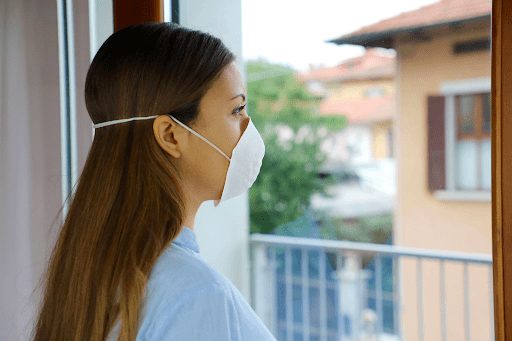The world of mental health has been significantly affected by the threat of the coronavirus. Many individuals are reported facing new or more severe issues of mental health, either directly or indirectly stemming from the pandemic. What does mental health under COVID-19 look like? Read on to find out.
The pandemic has brought on an array of concerns: contracting COVID-19 and suffering through the symptoms of this life-threatening illness, economic instability and a sharp rise in unemployment, long periods of isolation and the loneliness they has generated, and the significant sense of fear felt by at-risk populations, to name a few. As a result, many individuals have begun experiencing mental health conditions and symptoms. For some, this has been the first time they have had to face a mental health difficulty. For others, the pandemic has exacerbated existing conditions, causing them to become more severe or incessant.

Studies have already begun to show that the global threat of coronavirus has brought on a number of mental health problems.
A central component among the mental health conditions that have become more prominent under COVID-19 is stress. Experiencing adverse hypervigilance and an unpleasant focus on thoughts concerning possible threats is much more common during the pandemic. Fearing for the health of oneself or a loved one, losing one’s job or home, or becoming isolated from sources of comfort or support have all gone up in prevalence, as individuals all over the world continue to face this multi-sided issue.
Significant sadness, coupled with excessive crying and anhedonia (difficulty feeling joy) can also result from the pressures of the pandemic. This seems to be especially true due to the isolation caused by the coronavirus threat, which has led many to develop symptoms of depression.
Rates of distractibility and a difficulty concentrating has also been shown to have increased under COVID-19. Being preoccupied with pandemic-related concerns has made it harder to focus current tasks and follow through on one’s assignments.
The prevalence of physical aches and pains, such as headaches, have also been found to have increased due to the threat of the pandemic (as opposed to acting as a direct symptom from contracting the virus). It is the worry of all matters COVID that can cause individuals to manifest their concern through their body. And as they are not a symptom of the coronavirus itself, these aches can continue even after receiving a vaccine or acting in other ways to safeguard one’s physical health.
Beyond the above, standalone symptoms, COVID-19 has brought on a surge in a number of mental health and neurological disorders. Listed below are three of these conditions:
Unsurprisingly, major depressive disorder (MDD) rates have surged under COVID. The pandemic’s effects are reflected in research, such as an August 2020 meta-analysis that highlighted the significant increase in depression after pooling data from 12 separate studies. The meta-analysis noted that 25% of the general population has faced MDD during the pandemic—much more than the typical 7%. The rise in depressive cases due to COVID will likely continue being a serious issue for society to deal with: not only has corona-related depression been incredibly taxing on those experiencing it as well as their loved ones, but it has also drained global mental health services, which have struggled to provide individuals with the necessary support.

In addition to depression, anxiety and anxiety-based conditions like obsessive -compulsive disorder (OCD), have risen in prevalence. In fact, reports have found that patients with OCD, general anxiety disorder, or hypochondria, are all vulnerable to COVID-related anxiety.
One of several disorders to focus on unwanted, intrusive, and obsessive thoughts, OCD in particular can be triggered by periods in history where a tangible, concrete threat looms over the entire population. Such is the case for many individuals currently dealing with COVID-related OCD: their thought content can be centered on fear of illness or contamination (one of the most common OCD obsessions, beyond the coronavirus pandemic), a financial disaster scenario, obsessing over self-harm in situations of isolation, or a catastrophic outlook on the ramifications of present-day reality.
Through an emphasis on better hygiene, many individuals who have found themselves repeating actions relating to food sterilization or washing one’s hands, far beyond what is actually necessary. Such OCD-related compulsive actions have also been on the uptick, with many finding it exceedingly difficult to separate a level necessary vigilance, meant to protect their health, and an endless repetition on actions and rituals that do more to wear down their sense of relief and security than they help protect them.

The threats introduced by the coronavirus, such as financial instability and the danger to one’s health, would have likely driven many individuals to start smoking, as a way to self-sooth. However, under the very real threat that COVID-19 poses to the respiratory system, the current pandemic has thankfully seen many smokers quit smoking in an effort to fortify themselves against COVID.
A Report on the UK population, for example, found that over 300,000 smoking addicts have managed to quit smoking due to COVID-19-related concerns. Over 2.4 million smokers have additionally cut down on their smoking over similar concerns. These numbers represent the highest numbers that have been seen in a decade.
As optimistic as these statistics are, though, they do not reflect the adverse effects of nicotine withdrawal, which can be experienced by the most dedicated—or concerned—smoker trying to quit. For this reason, it is imperative to provide those looking to stop smoking with the tools and support they require to maintain their smoking cessation through the coronavirus pandemic and beyond.